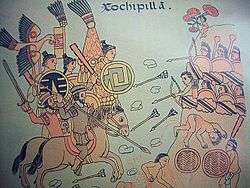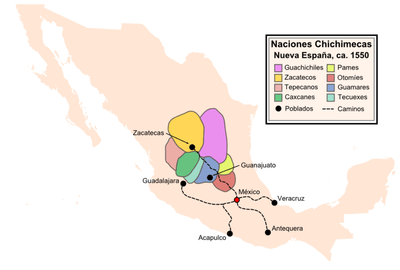Caxcan
The Caxcan were a partly nomadic indigenous people of Mexico. Under their leader, Tenamaztle, the Caxcan were allied with the Zacatecos against the Spaniards during the Mixtón Rebellion in 1540-42. During the rebellion, they were described as "the heart and the center of the Indian Rebellion". After the rebellion, they were a constant target of the Zacatecos and Guachichiles due to their ceasefire agreement with the Spaniards. Their principal religious and population centers were at Teul, Tlaltenango, Juchipila, and Teocaltiche.
 Caxcan warriors battling against the Spaniards | |
| Total population | |
|---|---|
| Unknown | |
| Regions with significant populations | |
| Mexico (Zacatecas and Jalisco) | |
| Languages | |
| Caxcan and Spanish | |
| Religion | |
| [[]] | |
| Related ethnic groups | |
| Other Chichimecas |

Over time, the Caxcans lost their culture due to warfare, disease, and marriage to non-Caxcans. Also, most of the Caxcans were sent into slavery by the Spanish to work in silver mines. During the colonial period, many Spanish (and some Basque settlers) had intermarried, or had relations, with the Caxcans making many Caxcan descendants Mestizos. The allied tribes and Mestizos settled the Caxcan lands in Zacatecas and Jalisco.
Their language was part of the Uto-Aztecan language family.
Their elected rulers were called tlatoani. Caxcan society was divided up into several different city-states.
The Chichimeca War
The Chichimeca War (1550–1590) was a military conflict waged between Spanish colonizers and their Indian allies against a confederation of Chichimeca Indians. It was the longest and most expensive conflict between Spaniards and the indigenous peoples of New Spain in the history of the colony.[1]
The Chichimeca wars began eight years after the Mixtón Rebellion (1540–1542). It can be considered as a continuation of that rebellion as the fighting did not come to a halt in the intervening years. Unlike in the Mixtón rebellion, the Caxcanes were now allied with the Spanish. The war was fought in the Bajío region known as La Gran Chichimeca, specifically in the Mexican states of Zacatecas, Guanajuato, Aguascalientes, Jalisco, and San Luis Potosi.
Post 1900s
The Council of the Caxcan Indians was formed in the 1920s by Juana Belén Gutiérrez de Mendoza, a Caxcan from Durango.[2] She also published Alto!, a book which stressed Mexican Nationalism through indigenous roots and, even after the alleged extinction of the Caxcan people, is quoted as saying "We do not recognize the right of any race to impose its civilization upon us" as a way to promote indigeneity.[2]
Notes
- LatinoLA | Comunidad :: The Indigenous People of Zacatecas
- Pouwels, Joel Bollinger. Political Journalism by Mexican Women During the Age of Revolution 1876-1940. New York: Edwin Mellen P, 2006]